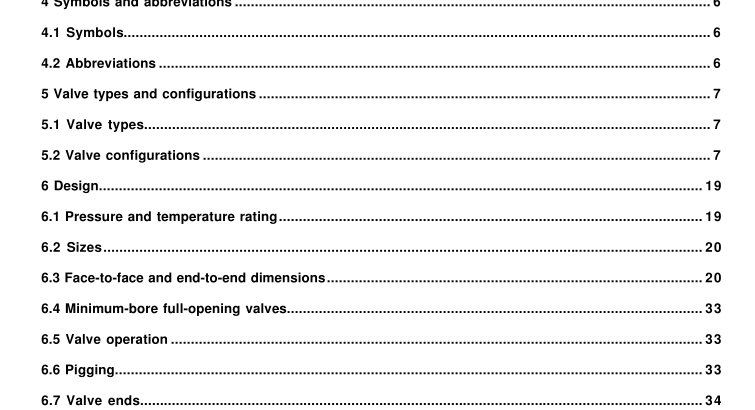API 6D:2002 pdf free download.Pipeline Valves API Specification 6D, Twenty-second Edition January 2002
6.4 Minimum-bore full-opening valves
Minimum bores for full-opening valves shall not be less than those specified in Table 1 .
6.5 Valve operation
The purchaser should specify the maximum pressure differential (MPD) at which the valve is required to be pened
by the lever, gearbox or actuator. If not specified, the pressure rating as determined in accordance with 6.1 for material at 38°C (100°F) shall be the MPD.
The manufacturer shall provide the following data to the purchaser:
the flow coefficient K v ;
the breakaway thrust or torque for new valve;
the maximum allowable stem thrust or torque on the valve and, if applicable, the drive train.
6.6 Pigging
The purchaser shall specify the requirements for piggability of the valves. Clause A.4 may be used to assist.
6.7 Valve ends
6.7.1 Flanged ends Standard end flanges shall be furnished with a raised face or ring joint faces (raised face or full face). Dimensions, tolerances and finishes, including drilling templates, flange facing, spot facing and back facing, shall be in accordance with:
ASME B1 6.5 for sizes up to and including DN 600 (NPS 24), except DN 550 (NPS 22);
MSS SP-44 for DN 550 (NPS 22);
ASME B1 6.47 Series A for DN 650 (NPS 26) and larger sizes.
6.7.2 Welding ends Welding ends shall conform to Figures 434.86 (a) (1 ) and (2) of ASME B31 .4 or Figures 1 4 and 1 5 of ASME B31 .8 unless otherwise agreed. In the case of a heavy-wall valve body, the outside profile may be tapered at 30° and then to 45° as illustrated in Figure 1 of ASME B1 6.25. The purchaser shall specify the outside diameter, wall thickness, material grade, SMYS and special chemistry of the mating pipe, and whether cladding has been applied.
6.7.3 Special flanges and mechanical joints Other end connections, such as special flanges or mechanical joints, may be specified by the purchaser.
6.8 Pressure relief The manufacturer shall determine whether fluid can become trapped in the body cavity in the open- and/or closedvalve position. If fluid trapping is possible, then valves for gas service, unless otherwise specified by the purchaser, and liquid service shall be provided with an automatic cavity pressure relief.
Cavity relief, when required, shall prevent the pressure in the cavity from exceeding 1 ,33 times the valve pressure rating determined in accordance with 6.1 for material at 38°C (100°F). External cavity relief valves shall be DN 1 5 (NPS 1 / 2 ) or larger.
6.9 Bypass, drain and vent connections Bypass, drain and vent connections and plug entries shall be drilled and threaded unless otherwise specified. The purchaser may specify other types of connections, such as welded or flanged.
Threads shall be either tapered and capable of providing a pressure-tight seal or parallel-threaded. Connections or plugs with parallel threads shall have a head section for trapping and retaining a sealing member suitable for the specified valve service. Thread sizes shall be in accordance with Table 7.
Thread forms shall be in accordance with ASME B1 .1 , ASME B1 .20.1 , ISO 228-1 , ISO 228-2 or ISO 7-1 .
6.10 Handwheels and wrenches (levers)
Wrenches for valves shall either be of an integral design or consist of a head which fits on the stem and is designed to take an extended handle. The head design shall allow permanent attachment of the extended section if specified by the purchaser.
The maximum force required at the handwheel or wrench to apply the breakaway torque or thrust shall not exceed 360 N.
Wrenches shall not be longer than twice the face-to-face or end-to-end dimension of the valve.
Handwheel diameter(s) shall not exceed the face-to-face or end-to-end length of the valve or 1 000 mm, whichever is the smaller, unless otherwise agreed. Except for valve sizes DN 40 (NPS 1 1 / 2 ) and smaller, spokes shall not extend beyond the perimeter of the handwheel unless otherwise agreed.API 6D pdf download.API 6D:2002 pdf free download
